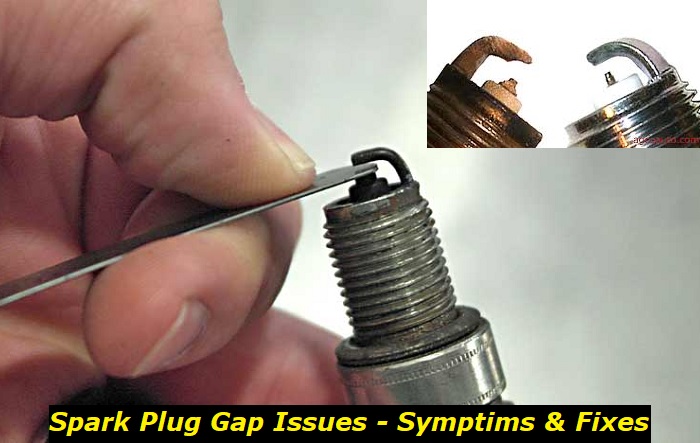Spark plugs play an essential role in the smooth functioning of an engine. These small but mighty components produce a spark that ignites the fuel-air mixture in the combustion chamber, allowing the engine to power up and run. However, there are instances when a spark plug's gap, the distance between the center and ground electrode, becomes too wide, causing a range of issues. So, what causes too much spark plug gap?
Hard engine starting highlights
- Level of urgency:Medium
- Can you drive?Yes, if it starts
- DIY inspection:Possible but complicated
- DIY repair:Mostly,impossible
- Price for repair:$200 - $750
- Common Reasons:Spark issues, carb problems, compression, engine problems
- Ways to fix:Inspect spark plugs, check compression, verify fuel supply is good

Why the Spark Plug Gap Matters
Spark plug gap may seem like a small detail, but it plays a vital role in your car's engine. The gap between the center and ground electrodes on the spark plug determines the strength and intensity of the spark that ignites the fuel in the engine. It might seem like a small distance, but even the slightest variation in the spark plug gap can have significant consequences for your engine's performance.
If the gap is too small, the spark becomes weak, resulting in incomplete combustion of the fuel-air mixture. This can cause a drop in power, increased fuel consumption, and even damage to your engine over time. On the other hand, a too-wide gap can cause the spark to jump too far, leading to misfires, rough idling, and a decrease in engine performance.
Moreover, different types of engines require different spark plug gaps. The gap is dependent on the engine's specifications and the type of fuel used. An incorrect gap size can cause your engine to work harder than it should, leading to unnecessary wear and tear.
A proper spark plug gap ensures that the fuel burns efficiently, maximizing the engine's performance and improving fuel efficiency. It also helps the engine produce less harmful emissions, which is better for the environment.
What is the Proper Spark Plug Gap?
The proper spark plug gap can vary depending on the make and model of your vehicle. The best way to determine the right gap is to consult your car's owner's manual, which will provide the recommended gap for your specific vehicle.
However, as a general rule of thumb, the standard gap for most vehicles is between 0.028 and 0.060 inches. But it's important to keep in mind that if your car has been modified or has aftermarket parts, the gap may need to be adjusted accordingly.
What Causes Too Much Spark Plug Gap
One of the most common reasons for excessive spark plug gap is normal wear and tear. Over time, the constant heating and cooling cycles of the engine cause the electrode to erode, eventually resulting in an increased gap. When the gap becomes too wide, it can weaken the spark produced, causing misfires and poor engine performance.
Let's take a closer look at some other causes of excess spark plug gap.
1) Incorrect installation
When a spark plug is not properly tightened or positioned, the gap can shift, causing it to be too wide. In some cases, inexperienced mechanics may even drop the spark plug, causing damage to the electrode and creating an excessive gap.
2) Heat
An engine running too hot can also cause the spark plug gap to widen. Heat causes the metal to expand, and if the engine is running too hot, the spark plug expands as well, causing the gap to widen.
3) Type of spark plug
Different spark plug brands and models have varying gap specifications. Using a spark plug with a wider gap than what is recommended for the engine can result in too much gap, leading to poor performance and even engine damage.
Symptoms of Improper Spark Plug Gap
An incorrect gap often results in several issues that affect the engine's performance, causing it to run roughly or damage it in the long run. Here are a few telltale signs that your engine is struggling with spark plug issues:
- Reduced engine power
When your spark plug gap is too large, the spark generated to ignite the fuel-air mixture may not be strong enough to produce adequate power. This results in a reduction in engine power, making your car feel sluggish and less responsive.
- Rough engine idling
You might notice that your car is vibrating or shaking while idle. This happens because the spark plug is not igniting the fuel-air mixture in the engine cylinders correctly, resulting in a rough idle.
- Engine misfiring.
A misfire is when the spark plug fails to ignite the fuel-air mixture at the right time, causing a small explosion inside the cylinder. This can result in a noticeable drop in engine power, as well as engine hesitation or surging.
- Poor acceleration
A larger gap will result in a weaker spark, which means less power is generated in the engine, resulting in reduced acceleration.
- Increased fuel consumption
When the gap is too small, the spark becomes weak, resulting in incomplete combustion of the fuel-air mixture. This, in turn, causes your engine to work harder to compensate, using up more fuel than necessary.
- Engine overheating
An improper spark plug gap can also cause your engine to overheat, leading to severe damage to the engine. This happens because the spark plug's heat range is not sufficient to handle the combustion temperature, causing the engine to run hot.
- Difficulty starting the engine
Finally, an improper spark plug gap can also cause difficulty starting the engine, especially in colder weather conditions. The spark plug may not generate enough spark to ignite the fuel-air mixture, making it hard for the engine to start.
How to Fix a Spark Plug Gap
The first step is to identify the problem. You can inspect the spark plugs visually, looking for signs of wear, such as corrosion, cracks, or fouling. You may also use a spark plug gap tool to measure the gap between the center and the ground electrode.
To fix a spark plug gap, you'll need a few tools, including a spark plug gap gauge, a socket wrench, and a screwdriver. Here are the steps to follow:
- Remove the old spark plug from the engine using the socket wrench.
- Use the spark plug gap gauge to measure the gap between the electrodes. If the gap is too narrow, gently pry open the gap using a screwdriver. If the gap is too wide, gently tap the ground electrode on a hard surface to close the gap.
- Check the gap again using the gauge to ensure it's within the manufacturer's recommended range.
- Install the new spark plug into the engine, making sure it's tightened to the correct torque.
- Repeat the process for each spark plug.
Note that not all spark plugs are adjustable. Some manufacturers make spark plugs with pre-set gaps, which means you can't adjust them. In this case, you'll need to replace the spark plug with a new one that has the correct gap.
Preventing Excessive Spark Plug Gap
Your spark plug gap being too wide can cause a range of problems so here are some tips for preventing it in the first place:
1) Follow your car's maintenance schedule
Make sure you stick to the manufacturer's recommendations for when to change your spark plugs. In general, spark plugs need to be replaced every 30,000 to 50,000 miles, but this can vary depending on the make and model of your car. Regular replacement of the spark plugs will ensure that the gap stays within the recommended range.
2) Check the gap before installation
Before installing new spark plugs, check the distance between the center and ground electrode of the plug. To check the gap, use a feeler gauge. If the gap is too wide, use a spark plug gap tool to gently bend the ground electrode until you reach the recommended gap.
3) Avoid dropping or damaging the spark plugs
Spark plugs are fragile, and dropping them or damaging them during installation can cause the gap to become too wide. Always handle the spark plugs with care, and make sure you don't drop them or damage them in any way.
4) Use the right type of spark plugs
Using the wrong type of spark plug can cause a range of problems, including excessive spark plug gap. So ensure you use the recommended type of spark plugs for your car.
Conclusion
Understanding the symptoms of too much spark plug gap is crucial for maintaining your vehicle's optimal performance. Whether it's reduced engine power or misfires address the issue as soon as possible to avoid causing further damage to your engine.
The good news is that fixing the problem is relatively easy and can be done with simple adjustments to the spark plug gap or by replacing the spark plugs entirely. By taking care of your vehicle's spark plug gap, you can keep your engine running smoothly and efficiently.
About the authors
The CarAraC research team is composed of seasoned auto mechanics and automotive industry professionals, including individuals with advanced degrees and certifications in their field. Our team members boast prestigious credentials, reflecting their extensive knowledge and skills. These qualifications include: IMI: Institute of the Motor Industry, ASE-Certified Master Automobile Technicians; Coventry University, Graduate of MA in Automotive Journalism; Politecnico di Torino, Italy, MS Automotive Engineering; Ss. Cyril and Methodius University in Skopje, Mechanical University in Skopje; TOC Automotive College; DHA Suffa University, Department of Mechanical Engineering






Add comment